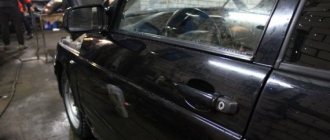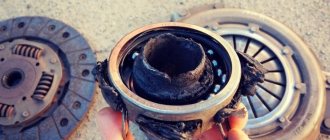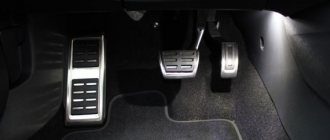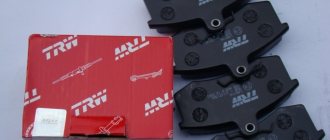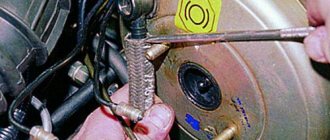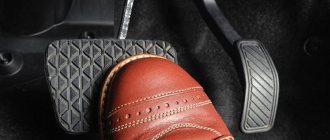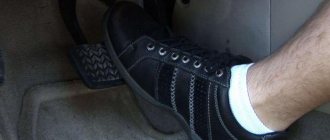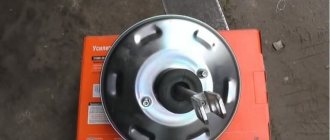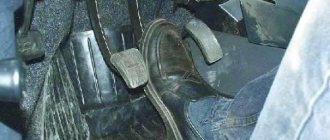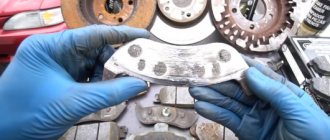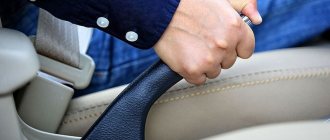Driving a vehicle always involves various risks. A high-quality braking system can avoid most of them. Thus, if you find a hard or soft brake pedal, you need to immediately address this problem. If such problems arise, you should not delay; it is better to conduct a thorough diagnosis to find out what exactly is the cause of the problem.
We will talk now about what actions to take if the brake pedal is soft, but when you press the brake the car slows down, as well as in other similar situations.
The main reasons for the brake pedal beating
Analyzing the reasons that can cause the brake pedal to beat, it is worth noting that they can be conditionally divided into direct, directly related to the braking system, and indirect, related to malfunctions of the suspension system, human factor and other similar manifestations.
So, among the main reasons it is worth highlighting the following:
- Warped brake discs are one of the most common problems. It usually occurs under the influence of a large number of heating/cooling cycles, causing deformation;
- Brake pad malfunctions are a problem that also occurs quite often and, as a rule, develops under the influence of long-term use;
- Rear brake drum - wear or distortion of this unit causes significant vibration in the brake pedal;
- Rear brake pads - here the root cause of the malfunction can be a number of destructive factors, including wear, crumbling and sticking of the drums;
- Brake cylinders, both front and rear, are a rather unpleasant situation in which acidification occurs and, as a result, the operating parameters of the elements deteriorate.
However, quite often, even correcting all of the above problems is not a guarantee of restoring system functionality. Here, as a rule, we are talking more about indirect factors that are not directly related to the system, but affect its operation.
Engine
The engine may shake on several occasions.
The most common problem occurs when engine mounts and support pads break. You can check this by rocking the engine yourself. If the engine shakes too much, the mounts are worn out. If the engine is shaking and colliding with other parts under the hood of your car, the mounting system needs a complete overhaul.
Problems can also arise when one of the cylinders does not work. This may be the result of troubles such as a burnt piston or a crack in the cylinder block. But usually it's all about the spark plugs or wires.
The electrical system can also cause problems with engine performance. If one of the cylinders is not firing, the engine will shake all the time and it will also lose power.
Rear brake drums, what condition are they in?
The cause of runout can be not only the rear brake pads, but also the brake drum itself. It may become bent or deformed during use. The contact of the pads with a deformed drum will inevitably lead to vibrations, which will also be felt in the brake pedal.
We recommend: How to properly check oil scraper rings and what is needed for this?
Steering
The steering rack and linkages can also cause vibration and shaking.
If the steering rack is faulty, the steering wheel may shake. Sometimes you may also feel some vibration on the pedals because the pedals and rack are usually mounted on the same metal board.
Rods and lugs can also cause problems. When they break, you will have difficulty moving the car in the desired direction. She will constantly try to change direction and put you in a dangerous situation. Additionally, broken steering parts can cause severe vibration that you will feel in your steering wheel. A certain knocking noise may also be heard. It is dangerous to continue to drive a car if the steering system of the car is faulty.
The brake pedal fails (the brakes are too soft)
It is worth noting that if you feel weak braking when pressing the brake of a VAZ 2109 or any other model, you need to think about the fact that these may be features of a particular vehicle. Perhaps you just moved from another car, so you feel some discomfort while driving a new car.
On the other hand, such a symptom can also occur when air enters the system. It should be noted that in the event of depressurization of the system, the pipeline may completely burst and completely fail. This can be corrected by bleeding the brakes. At the same time, you should diagnose the cylinders, check the level of the brake fluid, as well as its quality (often air gets into the brake system simply because there is too little fluid) and perform a full check of the vehicle (the latter will help determine the presence of hidden problems) ;
If the pedal becomes soft after replacing the brake fluid, then, as a rule, the problem lies in the use of a low-quality mixture. Alternatively, it is possible that air got into the system during replacement - this is also worth paying attention to.
It is also quite common for the pedal to feel soft after bleeding the brakes. First of all, you should bleed the master cylinder. As a rule, this solves a similar problem. Alternatively, there may be problems with the anti-lock braking system (if equipped). In any case, if the brakes are soft after bleeding, you should approach this task responsibly. Perhaps you should contact specialists who can quickly and effectively fix the problem.
Wheel problems
It is precisely problems with stingrays that cause the mentioned phenomenon in most cases. Let's consider them in descending order, according to the possible likelihood of their occurrence.
In 70% of cases of runout during braking at speed, wheel imbalance is to blame. Failure to adjust the ramp leads to the appearance of centrifugal force - the heavier part of the wheel pulls its center towards itself. The result is body shaking with vibration transferred to the steering wheel. The loss of one or more weights is determined simply: the beating appears at speeds greater than 60 km/h and when braking from there. When eliminating a defect, it is important not to make a mistake: correct balancing is carried out not on the pair of wheels where its violation was noticed, but on all 4.
The next most common reason is defects in tires and wheels. Flying into a hole or lateral collision with a curb disrupts the geometry of the latter, and the slope gives vibration not only to the steering wheel, but throughout the entire body. In some cases, it will not be possible to detect curvature visually. However, you can jack up the car and turn the wheel. If it is loose, take it to a tire shop and have it checked at a stand. As for tires, the culprit may be a manufacturing defect that led to the formation of lumps, or perhaps road damage to the cord.
Next in line is low tire pressure. It rarely happens to those who watch their wheels, but even the most attentive driver can run into a stud along the way. It is worth checking the pressure in the slopes and pumping them up to normal - perhaps such simple actions will immediately remove the beating.
Poor tightening of wheel bolts is a primitive reason, but often overlooked and, moreover, the cause of many accidents. Please note that it is possible for the bolts to spontaneously loosen while driving, say, on a “washboard”.
In any case, when runout occurs during braking, especially at high speeds, the wheels are carefully inspected first. If you were unable to find a defective one, go to a tire shop and entrust the diagnostics to professionals.
Why does the brake pedal hit when braking?
Why does the brake pedal squeal when you press the brake? Most often, when various malfunctions are detected, motorists turn to a specialized service.
At the mechanic station, you will most likely order the front brake discs and pads to be replaced, since they are changed together.
Yes, this is a common cause of “impacts” on the steering wheel or brake pedal, but there are still other malfunctions that give such a result. Let's consider what main malfunctions can cause such behavior of the car when the speed decreases.
- The first reason, which we have already described above, is deformation of the brake disc. Most often this happens due to severe overheating. The average operating temperature of a modern brake disc is 200-300 degrees. Overheated soft metal is prone to deformation, which causes irregularities to appear on the surface of the disk, which cause shocks. This problem can be solved by replacing the disks. If your driving style is quite aggressive, then you should consider purchasing brake discs that are more temperature-resistant. The ventilation of the disks, as well as their area, is responsible for heat resistance; the larger it is, the better the heat transfer.
- Wear of brake discs. With severe and uneven wear, scuffing may appear on the braking surface of the “pancake”, which will cause runout. Just a replacement solution. If the discs on one axle have uneven wear, it means that the braking of the right and left wheels occurs unevenly, which can also complicate driving and become a threat to life.
- Overheating of Ferodo coating on the pads. When the brake surface of the pads overheats, the friction linings simply begin to crumble, which is why they cannot properly and evenly press the brake disc and stop the wheel.
- Uneven or severe pad wear. Just like the surface of the disc, the braking surface of ferodo pads wears out over time. Wear may occur unevenly, which will affect the wear of the disc and the process of stopping the rotation of the wheel. Everything can be solved with a simple replacement. If the brake discs still have a sufficient layer of working surface and there are no defects, then you can only get by by replacing the pads as a pair on the axle. When installing new pads, be sure to clean the bracket, otherwise this may lead to the pad becoming sour over time. The pad must have free play in the bracket so that the caliper correctly presses its entire surface against the brake disc.
- Inoperative brake caliper cylinders. Another common problem is stuck pistons. This often happens due to torn boots of the brake pistons; because of this, dirt and moisture get into the brake cylinder, which “kills” the lubrication of the mechanism, which over time leads to souring and inoperability of the entire device. A caliper repair kit will help solve this problem. The kit will include a new boot, brake piston and lubricant. Everything is simple, you just need to “squeeze” the old piston out of the cylinder by pressing the brake pedal, then we clean everything, lubricate the cylinder walls, the piston and press it back, and install a new boot.
- Worn rear brake pads. Often noticeable only during heavy braking. Usually, in moderate driving mode, only the front mechanisms are involved in the braking process, the rear mechanisms are connected either later or during sharp braking. So if the beating does not occur with pressing the pedal, but later or towards the end, then this is most likely due to worn rear brake pads.
- Rear brake drums are worn or bent. When braking, the drum presses the pad unevenly or inconsistently, so there is no full contact between the pad and the braking surface, braking efficiency decreases and vibration is transmitted to the pedal or body. The reason for wear of these parts is most often their age, and the solution to this issue is simple - replacing worn out consumables with new ones.
- Severe wear on wheel bearings. Due to play and wear of the bearing working surface, vibration and hum are transmitted to the wheel. When braking, the front suspension of the car is loaded, which creates vibration from the bearing. It is possible to check bearing wear on a lift by checking the wheel for vertical play; if there is any, then the bearing has already “outlived” its usefulness and needs to be replaced.
- Incorrect wheel balancing. It rarely makes itself felt through the brake pedal; more often it hits the steering wheel. You can solve the problem by contacting a tire service. By properly balancing the wheels, the vibration will go away.
- The last problem may be that the nuts and bolts are not fully tightened. This is the reason for insufficient fixation of mechanisms, the appearance of backlash, which instantly causes vibration. In addition to the fact that this can also lead to early wear on parts, it will also affect the safety of the vehicle.
We recommend: Measuring compression in engine cylinders - a proven method for detecting faults with your own hands
Troubleshooting
Most troubleshooting work can be done independently. It is advisable to have an inspection hole, but you can even do without it. First of all, they check in motion. It is best to accelerate and brake at idle, so all violations will be more noticeable. As for checking, follow these instructions:
- Holding the wheel, shake it in different directions; it must be fixed tightly; any movement is unacceptable. If there is play, the problem may be either the bearing or hub wear.
- Dismantle the wheel and carefully inspect the disc. Any damage or wear is immediately visible, especially if the problem is serious. Rotate the disk, it should move evenly and not cling in a certain position.
- It is best to carefully remove the pads and inspect them for even wear and damage. If there is a little friction lining left, it is better to replace the elements.
- Remove the brake disc and make sure that its seat is clean; if there are deposits and rust, clean it with a wire brush.
- Check whether the brake cylinder is pressed in; the easiest way to do this is with a special device. If the caliper is blocked, you should replace it entirely or install a new brake cylinder.
Important!
Sometimes vibration is caused by a poorly tightened wheel. In this case, runout is observed constantly; you can check by stopping and inspecting the bolts or nuts. If they are loose, tighten them using considerable force.
Transmission
Again, the transmission mount and support pads should be checked first. Then check the fasteners. If the car shakes during acceleration, or the car accelerates jerkily, check the transmission itself. In robotic transmissions such as Ford Powershift or Volkswagen DSG, the clutch system may be broken. In a traditional automatic transmission, shaking can be a sign that the transmission is about to die. But sometimes an oil change can extend the life of your transmission and help you deal with the problem of shaking and jerking.
Fuel
Sometimes problems can be caused by the quality of the fuel. For example, if you fill up with diesel instead of gasoline at a gas station, the engine will begin to shake and vibrate, and then may simply stall. If you use low-quality fuel, the fuel filter will immediately become dirty, and it will be quite difficult for the fuel pump to provide the necessary pressure in the system. This can cause low fuel pressure in the fuel injectors, which can cause shaking and vibration.
